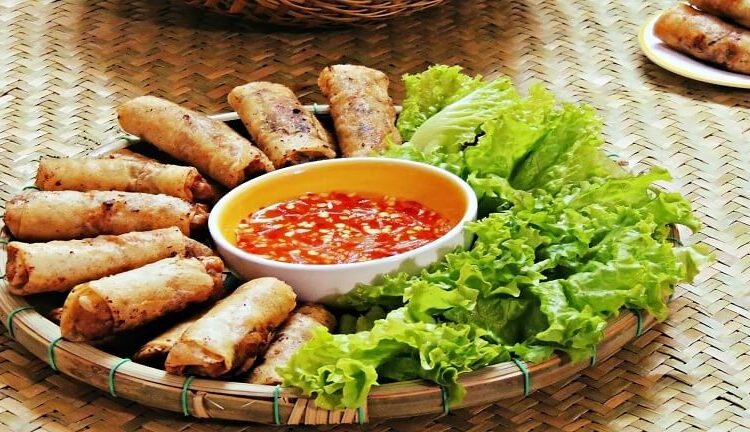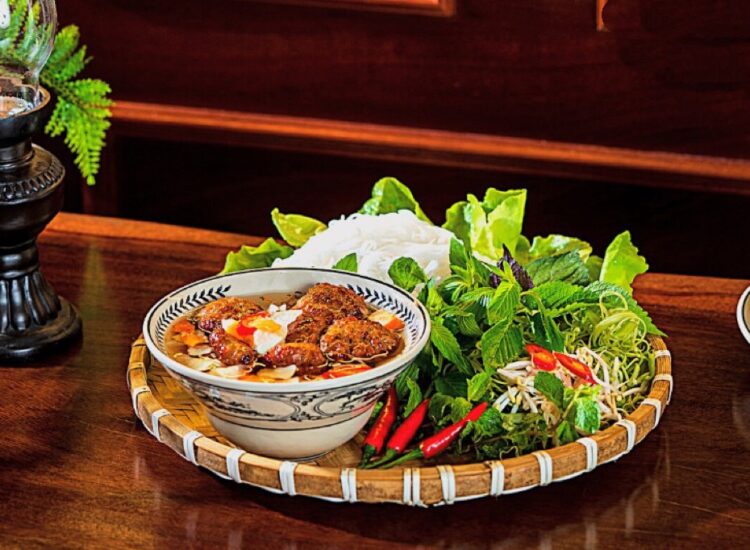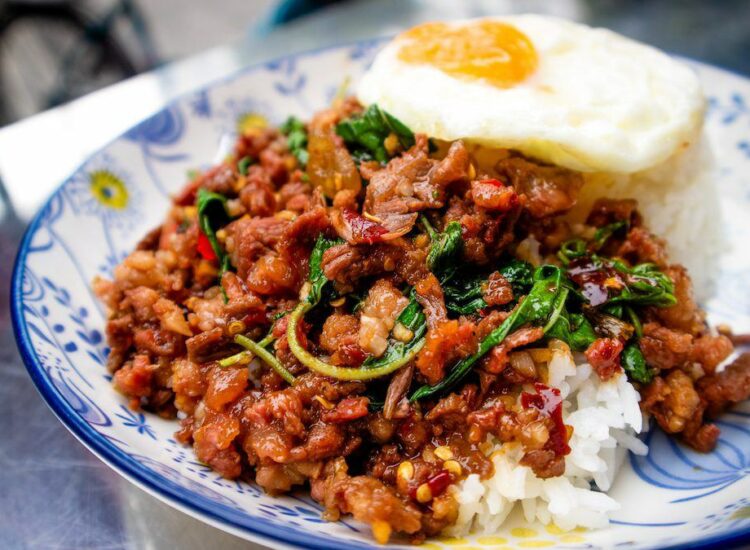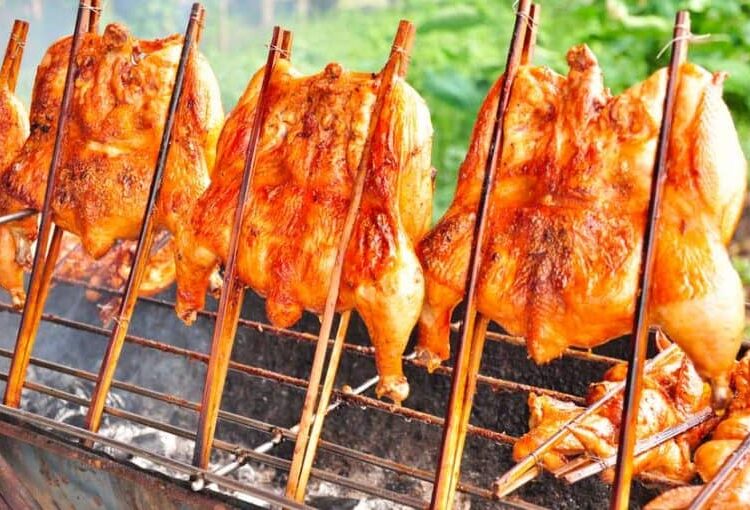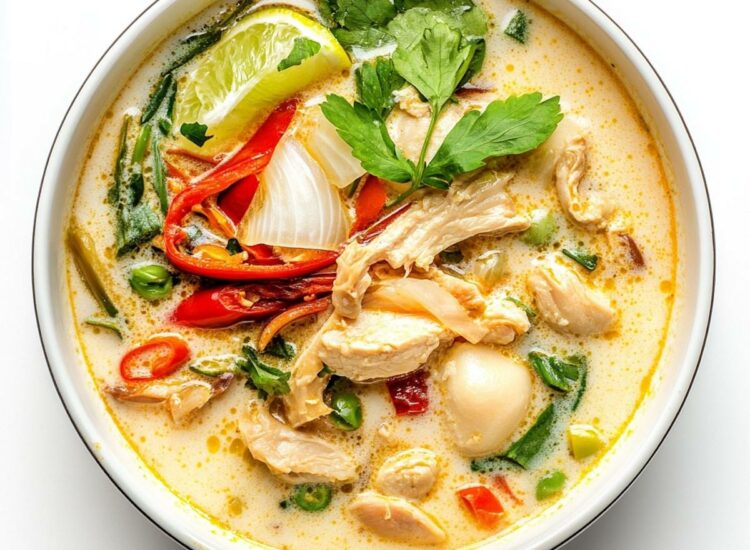The history of Massaman Curry is as complex and layered as its flavor profile, with various theories surrounding its origins. The name “Massaman” itself offers a significant clue, believed to be derived from “Mosalman,” an archaic Persian word for “Muslim” (Wikipedia). This linguistic connection points towards a likely Islamic influence in the curry’s creation.
One prominent theory suggests that Massaman Curry was introduced to Thailand during the 17th century in the Ayutthaya Kingdom, the ancient capital of Siam. Persian traders, possibly from the court of Ayutthaya, are often credited with bringing the dish and its unique spice blend to the region (Thai Square). Some accounts even name a specific Persian merchant, Sheik Ahmad Qomi, as a key figure in introducing Massaman Curry to the Siamese court (Thai Square).

Another perspective suggests a broader influence from Muslim traders and communities from India and Malaysia, who had established trade networks with Southern Thailand. These culinary exchanges likely contributed to the development of Massaman Curry, blending local Thai ingredients with spices and cooking techniques from the Middle East and South Asia (Uwajimaya).
Interestingly, some theories propose a Khmer origin for the dish, suggesting it was developed by ethnic Khmer people in Ayutthaya. The word “massam” in Khmer means “to make,” which aligns with the complex preparation of the curry (Parawan Thai Cooking Class). This theory connects Massaman Curry to an older Cambodian dish called “Saran Curry,” a beef and coconut curry with similar spices, potentially dating back centuries and reflecting ancient culinary links between India and the Champa kingdom (YouTube).
Regardless of the precise origin, Massaman Curry gained prominence within the Thai royal court. It is notably mentioned in the poem “Kap He Chom Khrueang Khao Wan,” written in the late 18th century and attributed to Prince Itsarasunthon, who later became King Rama II (Wikipedia). This royal association elevated the status of Massaman Curry, marking its transition from a potentially regional or community-based dish to a recognized part of Siamese courtly cuisine.
The first recorded recipe for Massaman Curry appeared much later, in 1889, in a cookbook by Lady Plean Passakornrawong. Her version, “Chicken Massaman Curry with Bitter Orange Juice,” provides a glimpse into the dish’s preparation at that time and highlights the use of distinctive ingredients like bitter orange juice (Thai Square).
Over time, Massaman Curry evolved, incorporating regional preferences and readily available ingredients. Despite these adaptations, it retained its core characteristics: a mild, coconut milk-based curry enriched with a unique blend of spices not typically found in other Thai curries. Today, Massaman Curry is celebrated globally as a quintessential Thai dish, enjoyed for its complex yet comforting flavors and its fascinating historical tapestry.
The Symphony of Flavors: Key Ingredients in Massaman Curry
Massaman Curry’s distinctive flavor profile arises from a carefully balanced combination of ingredients, setting it apart from other Thai curries. While red and green curries emphasize fresh herbs and chili heat, Massaman Curry leans towards warm, aromatic spices and creamy coconut milk, creating a milder and more savory experience.
The essential components of Massaman Curry can be categorized into:
1. Curry Paste: The heart of Massaman Curry lies in its unique curry paste, which is less about fiery chilies and more about aromatic spices. Key ingredients in Massaman curry paste typically include:
- Dried Red Chilies: Providing a mild heat and color.
- Shallots and Garlic: Forming the aromatic base.
- Galangal and Lemongrass: Adding citrusy and earthy notes characteristic of Thai cuisine.
- Coriander Seeds and Cumin Seeds: Lending warm, earthy, and slightly citrusy flavors, reflecting Indian and Middle Eastern influences.
- Cinnamon, Cloves, Nutmeg, and Star Anise: These warming spices are crucial for Massaman’s signature aroma and flavor complexity, distinguishing it from other Thai curries. They contribute sweet, woody, and slightly pungent notes, further highlighting the dish’s multicultural heritage.
- White Peppercorns: Adding a subtle heat and pungency.
- Shrimp Paste (Kapi): Providing a savory umami depth, although some vegetarian versions omit this.
2. Coconut Milk: Coconut milk is indispensable in Massaman Curry, contributing richness, creaminess, and a subtle sweetness that balances the spices. It mellows the heat and binds all the flavors together, creating a luscious and comforting sauce.
3. Meat: Traditionally, beef is the most common protein in Massaman Curry, particularly shank or chuck, which become tender and flavorful during the long cooking process (Wikipedia). Chicken and lamb are also popular choices, offering variations in texture and flavor. Vegetarian adaptations often incorporate tofu or vegetables like potatoes and pumpkin.
4. Potatoes and Onions: These vegetables are essential additions, providing substance and sweetness to the curry. Potatoes absorb the flavorful sauce and become meltingly tender, while onions caramelize and contribute depth.
5. Peanuts or Cashews: Roasted peanuts or cashews are a signature ingredient, adding a distinctive nutty flavor and textural contrast to the creamy curry. They contribute to the overall richness and complexity of the dish.
Related articles 01:
1. https://chobangkaewthai.com/khao-soi-a-culinary-journey-into-northern-thailands-iconic-noodle-soup
2. https://chobangkaewthai.com/nem-ran-cha-gio-tinh-hoa-am-thuc-viet-nam-vuon-tam-the-gioi
3. https://chobangkaewthai.com/best-thai-food-of-2025
4. https://chobangkaewthai.com/nom-yen-a-refreshing-drink-not-to-be-missed
5. https://chobangkaewthai.com/bun-cha-a-culinary-journey-into-vietnams-iconic-grilled-pork-and-noodles
6. Tamarind Paste: Tamarind paste introduces a crucial sour note that balances the sweetness and richness of the curry. Its tangy flavor brightens the overall profile and adds a layer of complexity. In some older recipes, bitter orange juice was used instead of tamarind, as seen in Lady Plean Passakornrawong’s recipe (Thai Square).
7. Fish Sauce and Palm Sugar: These quintessential Thai ingredients are used to season Massaman Curry, providing saltiness and sweetness respectively. Fish sauce adds umami depth, while palm sugar contributes a caramel-like sweetness that complements the spices.
8. Bay Leaves and Cardamom Pods: These whole spices are often added to the curry during cooking, further enhancing the aromatic complexity. Bay leaves impart a subtle tea-like note, while cardamom pods offer a fragrant, slightly citrusy aroma.
9. Optional Ingredients: Depending on regional variations and personal preferences, Massaman Curry may also include ingredients like:
- Carrots: Adding sweetness and color.
- Pineapple: Introducing a tropical sweetness and tanginess.
- Bell Peppers: Contributing sweetness and a slight vegetal note.
- Lime Juice: Adding a final touch of acidity and freshness, often squeezed over the curry before serving.
The interplay of these ingredients is what makes Massaman Curry so unique and beloved. The warm spices, creamy coconut milk, tangy tamarind, and nutty peanuts create a harmonious blend of flavors that is both comforting and complex.
Crafting the King: Preparing Authentic Massaman Curry
Making Massaman Curry is a rewarding culinary endeavor that involves layering flavors and patiently simmering the ingredients to perfection. While it requires a slightly longer cooking time compared to some other Thai curries, the resulting depth of flavor is well worth the effort.
Here’s a general outline of the traditional preparation method:
1. Making the Curry Paste (or using a high-quality store-bought paste):
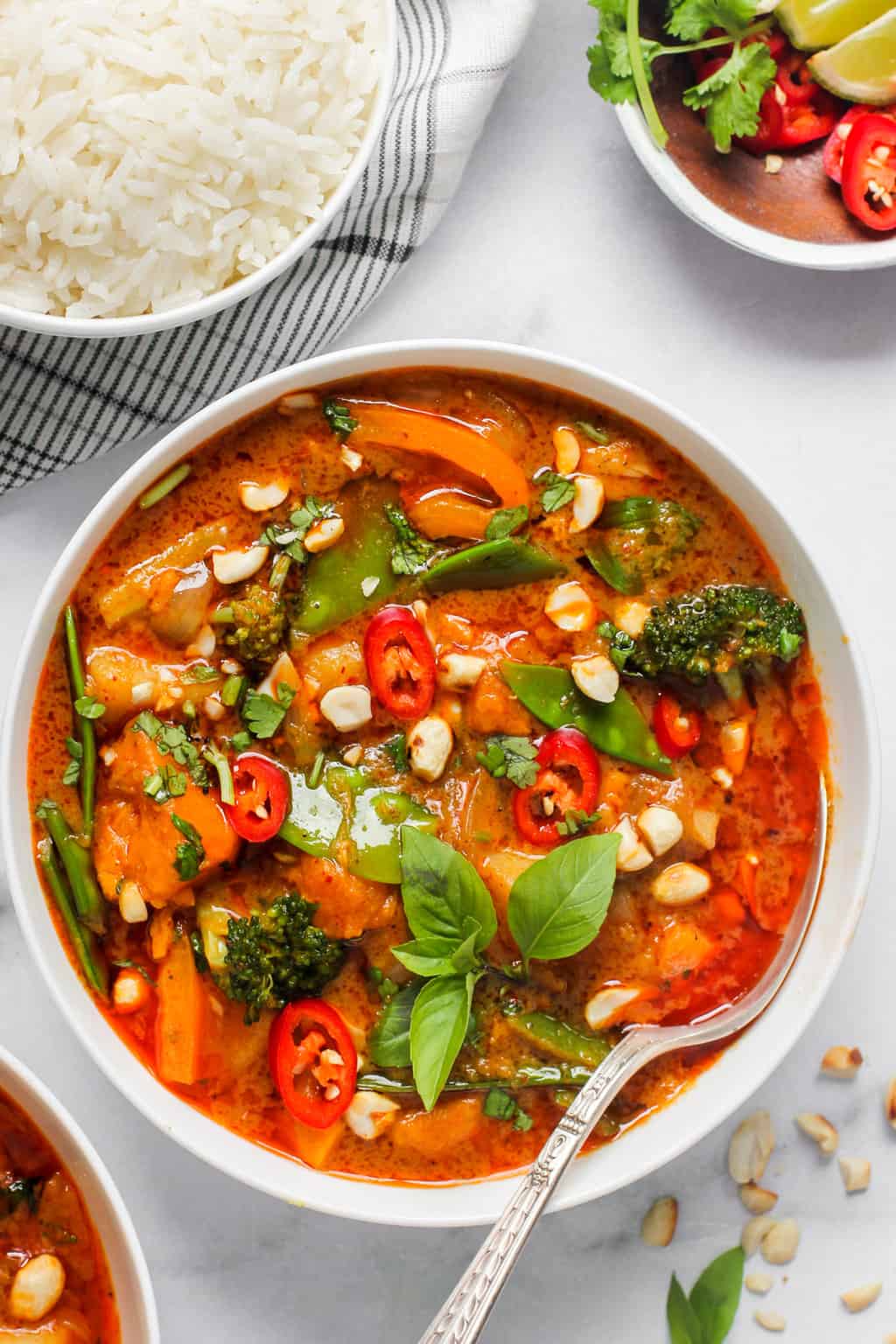
- If making from scratch: Toast coriander seeds and cumin seeds until fragrant. Grind all curry paste ingredients (dried chilies, shallots, garlic, galangal, lemongrass, toasted coriander and cumin seeds, cinnamon, cloves, nutmeg, star anise, white peppercorns, shrimp paste if using) into a fine paste using a mortar and pestle or a food processor. The homemade paste will offer the most authentic and vibrant flavor.
- Using store-bought paste: Choose a reputable brand of Massaman curry paste. While convenient, store-bought pastes may vary in flavor and spice levels, so taste and adjust seasonings accordingly.
2. Preparing the Meat and Vegetables:
- Meat: Cut beef (shank or chuck), chicken, or lamb into bite-sized pieces. For vegetarian versions, prepare tofu or vegetables like potatoes, onions, and carrots.
- Potatoes and Onions: Peel and cut potatoes and onions into chunks of similar size.
3. Sautéing the Curry Paste:
- Heat coconut oil or vegetable oil in a large pot or Dutch oven over medium heat.
- Add the Massaman curry paste and sauté for several minutes, stirring constantly, until fragrant and the aroma intensifies. This step is crucial for releasing the flavors of the spices.
4. Incorporating Meat and Coconut Milk:
- Add the meat to the pot and cook, stirring, until browned on all sides.
- Pour in thick coconut milk (the creamy top layer of canned coconut milk) and stir well to coat the meat with the curry paste.
- Simmer for a period of time, allowing the meat to absorb the flavors and tenderize. The cooking time will vary depending on the type of meat used; beef typically requires longer simmering.
5. Adding Vegetables and Spices:
- Add potatoes and onions to the pot.
- Pour in the remaining thinner coconut milk.
- Add tamarind paste, fish sauce, palm sugar, bay leaves, and cardamom pods.
- Bring to a simmer, then reduce heat to low and cook gently until the potatoes are tender and the sauce has thickened. This slow simmering process allows the flavors to meld beautifully.
6. Finishing Touches:
- Stir in roasted peanuts or cashews.
- Taste and adjust seasonings as needed, adding more fish sauce for saltiness, palm sugar for sweetness, or tamarind paste for sourness.
- Simmer for a few more minutes to allow the flavors to fully integrate.
- Garnish with fresh cilantro or a squeeze of lime juice before serving, if desired.
7. Serving:
- Serve Massaman Curry hot, traditionally with steamed jasmine rice. It can also be enjoyed with roti or other types of bread to soak up the flavorful sauce.
- Massaman Curry is often served as part of a Thai meal alongside other dishes, offering a milder and more savory counterpoint to spicier curries and stir-fries.
Tips for Perfect Massaman Curry:
Related articles 02:
1. https://chobangkaewthai.com/kai-yang-the-ultimate-guide-to-thai-grilled-chicken
3. https://chobangkaewthai.com/khao-soi-a-culinary-journey-into-northern-thailands-iconic-noodle-soup
4. https://chobangkaewthai.com/oliang-thai-coffee-you-shouldnt-miss
- Use good quality coconut milk: Full-fat coconut milk is essential for the richness and creaminess of Massaman Curry.
- Don’t rush the sautéing of the paste: Sautéing the curry paste properly is crucial for developing its full flavor.
- Simmer gently: Slow simmering allows the meat to become tender and the flavors to meld.
- Taste and adjust seasonings: Adjust the balance of sweet, sour, salty, and spicy to your preference.
- Roast nuts for extra flavor: Roasting peanuts or cashews before adding them to the curry enhances their nutty aroma and flavor.
- Make it ahead: Massaman Curry often tastes even better the next day as the flavors deepen overnight.
A Culinary Tapestry: Regional and Modern Variations
While the core elements of Massaman Curry remain consistent, regional variations and modern adaptations have emerged, reflecting local preferences and culinary creativity.
Regional Variations within Thailand:
- Southern Thailand: Given its likely origins in Southern Thailand, the region often features more robust and spicier versions of Massaman Curry. Malay influences may be more pronounced, with a potential use of ingredients like dried shrimp or belacan (shrimp paste) to enhance the umami flavor.
- Central Thailand: Central Thai Massaman Curry tends to be milder and sweeter, aligning with the overall flavor profile of Central Thai cuisine. It often emphasizes the balance of sweet, sour, and savory notes.
- Northern Thailand: While less common than in other regions, Massaman Curry in Northern Thailand might incorporate local ingredients and spices. However, Northern Thai cuisine is generally more known for its distinct curries like Khao Soi and Hang Lay Curry.
Variations Beyond Thailand:
- Malaysian and Singaporean Influences: In Malaysia and Singapore, where Malay and Indian culinary influences are strong, Massaman Curry may be adapted to local tastes, potentially incorporating more coconut milk, sweeter spices, or different types of vegetables.
- Western Adaptations: In Western countries, Massaman Curry has gained immense popularity in Thai restaurants. Adaptations may occur to cater to Western palates, sometimes resulting in sweeter or milder versions. Vegetarian and vegan Massaman Curry options are also widely available, substituting meat with tofu, vegetables, or plant-based protein alternatives.
Modern Twists and Creative Interpretations:
- Seafood Massaman Curry: Some modern interpretations replace traditional meats with seafood like prawns or fish, offering a lighter and faster-cooking version.
- Duck Massaman Curry: Duck, with its rich and flavorful meat, can be a luxurious alternative to beef or chicken in Massaman Curry.
- Lamb Shank Massaman Curry: Using lamb shanks elevates the dish, resulting in incredibly tender and flavorful meat that falls off the bone.
- Massaman Curry with Tropical Fruits: Incorporating fruits like pineapple or mango can add a refreshing tropical sweetness and acidity to the curry.
- Deconstructed Massaman Curry: Some chefs have experimented with deconstructed presentations of Massaman Curry, separating the components and highlighting individual flavors in a more refined plating.
These variations demonstrate the adaptability and enduring appeal of Massaman Curry. While staying true to its core flavor principles, chefs and home cooks continue to explore new ingredients and techniques, ensuring its relevance and enjoyment in diverse culinary contexts.
More Than Just a Dish: The Cultural Significance of Massaman Curry
Massaman Curry is more than just a delicious meal; it holds cultural significance within Thailand and beyond. Its history reflects the country’s openness to foreign influences and its ability to integrate diverse culinary traditions into its own unique identity.
A Symbol of Cultural Exchange: Massaman Curry embodies the historical interactions between Thailand and other cultures, particularly Persia, India, and Malaysia. Its spice blend and flavor profile are a testament to the trade routes and cultural exchanges that have shaped Southeast Asian cuisine. It showcases how Thailand has absorbed and adapted foreign culinary elements, creating something distinctly Thai yet globally influenced.
Royal and Refined Cuisine: Its mention in royal poetry and its presence in Lady Plean Passakornrawong’s cookbook indicate Massaman Curry’s association with Thai royalty and refined cuisine. This historical connection elevates its status beyond everyday fare, positioning it as a dish worthy of special occasions and celebrations.
Comfort Food with Global Appeal: Despite its complex history and sophisticated flavor profile, Massaman Curry is also deeply comforting and approachable. Its mild spice level and creamy texture make it appealing to a wide range of palates, contributing to its global popularity. It has become a staple in Thai restaurants worldwide, introducing people to the nuanced flavors of Thai cuisine beyond the more fiery curries.
A Reflection of Thai Culinary Philosophy: Massaman Curry exemplifies the Thai culinary philosophy of balancing flavors – sweet, sour, salty, spicy, and bitter. While it leans towards the milder and sweeter side compared to other Thai curries, it still maintains a harmonious balance of these elements. The careful layering of spices and the interplay of textures demonstrate the Thai emphasis on culinary artistry and achieving a nuanced flavor profile.
A Dish for Special Occasions: In Thailand, Massaman Curry is often served at special occasions and family gatherings. Its rich and flavorful nature makes it a celebratory dish, enjoyed during festivals, holidays, and important family meals. It is a dish that brings people together, fostering a sense of warmth and shared culinary heritage.
A Culinary Ambassador for Thailand: Massaman Curry has become a culinary ambassador for Thailand on the global stage. Its widespread popularity in international Thai restaurants has introduced millions to the richness and diversity of Thai cuisine. It often serves as an entry point for those unfamiliar with Thai food, offering a gateway to explore other, perhaps more adventurous, Thai dishes.
In conclusion, Massaman Curry is far more than just a Thai curry; it is a culinary masterpiece with a rich history, a symphony of flavors, and significant cultural weight. From its debated origins to its global recognition, Massaman Curry stands as a testament to the power of food to transcend borders, blend cultures, and create enduring culinary traditions. Whether enjoyed in a royal Thai palace, a bustling Bangkok street food stall, or a cozy home kitchen, Massaman Curry continues to enchant and delight, solidifying its place as the “king of curries” and a cherished part of Thai culinary heritage.

